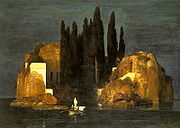Culture Vulture: BSO’ s Death-drenched Russian program
By Helen Epstein
Oct-8-13 Stravinsky, Rachmaninoff and Shostakovich
Symphony Hall
Boston, MA
Vasily Petrenko, conductor

This image by the Swiss painter Arnold Bocklin inspired Rachmaninoff.
Audiences as well as composers project their emotions and fantasies onto every piece of art with which they engage, but I think this is particularly true of instrumental music, whose non-verbal, non-visual yet powerfully emotional expressiveness is as open to multiple interpretation as a Rorschach test. Often composers intend their music to follow a program: to narrate an explicit story, or evoke a season, mood, a place.
But sometimes these extra-musical “handles” are ex post facto — Beethoven’s “Moonlight Sonata” for instance or the association of Rossini’s “William Tell Overture” to the Lone Ranger TV series, Who can say with any certainty what a piece of music is “about”?
I was thinking about this last Friday during the BSO’s unusual and unusually death-suffused program of Russian music, conducted by the brilliant 33-year-old St. Petersburg-born conductor Vasily Petrenko. Both the prospect of hearing a post-Soviet conductor and the novel program brought me to Symphony Hall. The orchestra had performed Stravinsky’s early Scherzo fantastique just three times in its history and its last performance of Rachmaninoff’s “The Isle of the Dead” had been in 1945. Although the Shostakovich 10th was performed twice in this century, it was neglected for the preceding 40 years. I had never heard any of the three pieces in concert.
I prepped by listening to the BSO’s excellent on-line program notes prepared by Richard Dyer. In them (I recommend listening to these audio notes wherever and whenever if you’re interested in a quick classical music tutorial), he points out that Stravinsky was notorious for disavowing any extra-musical connotations of his music. “I consider that music is by its very nature essentially powerless to express anything at all,” Stravinsky (or his ghost) wrote in his autobiography, “whether a feeling an attitude of mind, a psychological mood, or a phenomenon of nature.”
This, as Dyer points out, is a little hard to take seriously from the composer of “the three most famous storytelling ballets of the 20th century” and, as we hear in the Scherzo fantastique. In fact, Stravinsky composed the coolly elegant scherzo — full of swarming and unmistakably bee-like allusions — after reading Maurice Maeterlinck’s “Life of the Bees” and at a time when his teacher Rimsky-Korsakov had a contemporary hit with a piece from one of his operas called “Flight of the Bumble Bee.”
Stravinsky’s is a sparkling short piece performed with great elan by a conductor clearly at home in the idiom. It features every section of the orchestra and two harps. Petrenko’s interpretation kept me on the edge of my seat.
Sergei Rachmaninoff thought very differently from Stravinsky about the relation of his music to outside phenomena. He found it helpful to have in mind a book or picture or poem when composing and made clear the source of his inspiration. In the case of “The Isle of the Dead,” it was a wildly popular, dream-like painting by the Swiss painter Arnold Bocklin that anticipates the surrealists. Hitler allegedly bought one of four original versions of it in 1933 and both Freud and Lenin had prints of it hanging in their rooms. What that means is also open to wide interpretation but the music Rachmaninoff composed for “The Isle of the Dead” is appropriately mysterious, dark, dramatic, and — to me — sounds very Russian — heavily sonorous, lushly orchestrated, and massive.
 The Brilliant Russian Conductor Vasily Petrenko” title=”vasily_petrenko_2″ width=”150″ height=”224″ class=”size-full wp-image-2984″ />
The Brilliant Russian Conductor Vasily Petrenko” title=”vasily_petrenko_2″ width=”150″ height=”224″ class=”size-full wp-image-2984″ />Conductor Vasily Petrenko
The notion of program music and extra-musical contexts takes on a whole other dimension with Dimitri Shostakovich and the Soviet Union’s political program for the arts. In his comprehensive and useful book “The Symphony”, the late and erudite musicologist Michael Steinberg wrote that Shostakovich (1906-1975) was “a man who could not commit himself to heroism or to moral and intellectual slavery, one whose actions and statements cover the gamut from the noble to the base,,,whose achievement is so uneven, not just between compositions but within them…it is hard to think of another composer whose work is so intensely, so immediately, so drastically affected by life.”
In January of 1936, Josef Stalin attended the composer’s opera “Lady Macbeth of Mtsensk District,” and hated it. Although Shostakovich was neither imprisoned nor killed, he was censored by “Pravda,” condemned by some of his less heroic musical colleagues, and designated an “enemy of the people.” For the rest of his life, everything he composed was heard through the screen of politics. In 1937, he produced his popular “Fifth Symphony” that a reviewer dubbed ” a Soviet artist’s creative answer to just criticism” and that is probably his most popular today but his career and his music were never free of the extra-musical taint of politics.
Despite his lifelong political troubles, Shostakovich wrote 15 symphonies. He began work on the 10th a few weeks after Stalin’s death in 1953 and the work therefore became a political symbol and subject of much discussion at the Soviet Composers Union the following year: is the first movement a lament for the millions dead? is the second a portrait of Stalin? does the composer make clear the authenticity of this — as opposed to other work — by writing his initials of his name into the musical notation?
All these extra-musical considerations play a role in how one hears this music and helps the listener make sense of it but, in the end, you are listening to music, a performance of the work — not an exegesis of it. Apart from the short and savage second movement, I found this performance of the “Tenth” long-winded, proceeding by fits and starts, not well enough put together. But I’m not familiar with this symphony and think that may be a flaw of the piece rather than Petrenko’s conducting of it.
Meanwhile, the Boston Symphony sounds wonderful, even in its maestro’s absence.
Helen Epstein ‘s book of profiles of celebrated musicians “Music Talks” is being republished by the Authors Guild Back-in-Print series and will be available in November.
